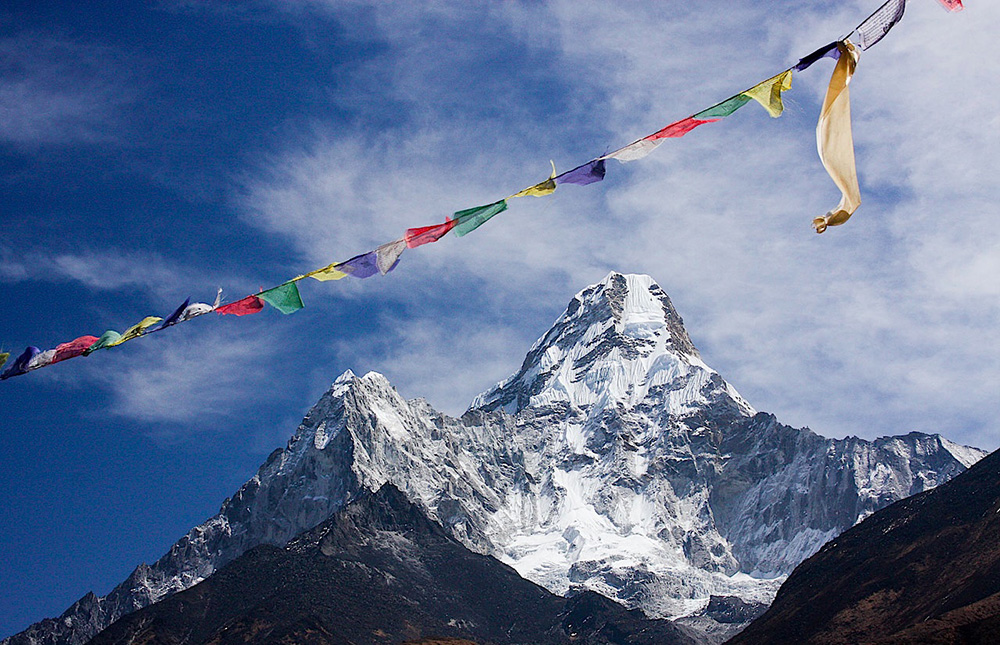The Himalayas, in Nepal, are like no other place on Earth. Towering peaks, clean air, and a welcoming cultural climate have brought me back not once, not twice, but three times over the years — and, along the way, I’ve picked up a trick or two about what to pack. Here’s what you should bring with you if you’re considering a trek to the Himalayas.
1. A water bottle
You should pack both a hard-sided plastic or metal bottle and a hydration pack. Bringing your own water storage will help relieve this fragile ecosystem of the scourge of discarded single-use plastic bottles, which you’ll see littering the trails as you hike. It’s best to not add to the problem.
The hard-sided bottle makes refilling and filtering easy. Though the water in the Himalayas can be fairly clear of organic matter, it’s what you can’t see that can make your time in the mountains uncomfortable. For that reason, consider packing a Steripen, which is a device that uses UV light to kill any parasites that can cause digestive problems. Fill the water bottle from any tap source or stream, run the Steripen for a minute and you will have clean, great-tasting water.
Once the water is safe to drink, transfer it to the hydration pack to keep yourself hydrated while you trek. The pack and its ever-present straw will help ensure that you drink often, which will help you stay strong enough to keep going.
One additional bonus of bringing your own bottle: you can fill it with hot water just before you go to bed and use it to keep your toes toasty until dawn. Then, zap it with your Steripen in the morning, and you’re ready to hit the trail!

The bright sun of the Himalayas means packing a good pair of sunglasses for your trek is a must. Photo courtesy of Alex.
2. A notebook
Even if you don’t journal every day, a small notebook can serve many purposes.
Some Moleskine-brand notebooks have a pocket in the back where you can store important small documents, receipts, business cards, or other mementos — I cut a hole through a few pages to make an easy storage area for a SpacePen.
Notebooks are a great way to communicate, as well. I have had friends draw maps and directions to must-see spots so I’m not entirely dependent on my phone’s map (and battery). If you don’t have business cards with you, just rip out a page and pass on your contact information to new friends you will undoubtedly make along the way.
They are also great for jotting down new phrases you learn while on the road, for keeping score during card games, and tracking expenses — should you be so inclined to stay on budget. Plus, they’re on hand to store all the enlightening ideas that pop into your head as you try your best to check out from your day-to-day worries and enjoy time on the road.

A water bottle and hydration pack will help keep you hydrated as you hike the Himalayas.
3. A good camera
Yes, your phone’s camera will work, but for truly spectacular shots, you’ll want to bring something with a decent zoom and extra storage. I suggest an entry-level DSLR and an 18–200mm lens, if you want to keep things simple and compact. Electricity can be spotty — or costly — at times in the Himalayas, so bring two extra batteries if you can fit them.
Cameras with GPS, which are relatively new to the market, are a boon to the frequent traveller: no need to remember exactly where you were when you took that amazing photo, since, with these cameras, it’s all recorded as you shoot.
4. Sunglasses
Some of my trips to Nepal started in Seattle, where during any month but July and August, I don’t have a clue where my sunglasses are. That can be a real problem in the Himalayas. The sun is intense at high altitudes, which, in the absence of decent shades, can turn a fun trip into a bad one in just one day. There are sunglasses for sale in Nepal, but quality can be questionable. And while we’re on the topic of the sun, bring some sunscreen, too. And a hat.
5. Photos of home
You’re travelling far from home because you want to see something new and exciting. Why not bring something new to those you visit? Bringing pictures from home (I prefer printed pictures for ease of use) helps break through any language barrier you may experience. You can also pack photos of your family, your actual house, or pets; these are all great conversation starters, and a way to bring your worldview to those you visit.

The bright sun of the Himalayas means packing a good pair of sunglasses for your trek is a must. Photo courtesy of Sam H.
Bonus items: Credit card and cash
Yes, there are ATMs in Nepal, and tourism is the country’s top industry, but that doesn’t mean getting to your cash is as easy as it is when you are close to home. I suggest most travellers bring enough cash to cover a few days of travel. Dollars, Euros, and pounds are easiest to exchange once you are on the ground (though the exchange rate will be less competitive than one you’d get from your bank).
Trekking in Nepal’s Himalayas can be a life-changing, affirming experience. The key to an amazing trip is being prepared with the essentials, so serendipity can take over and reveal the world to you.
Getting there
Ready to hike the Himalayas? G Adventures can get you there. We run a number of trips to Nepal that comprise everything from active getaways to leisurely retreats. We're excited at the prospect of showing you more of this big, beautiful planet — check out our small group tours to Nepal here.






















